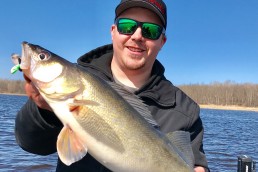River Walleyes or Spring Binge Panfish
SHARE THIS POST
In Brian Brosdahl’s neck of the woods, the Rainy River offers some of the best early season opportunities for walleyes. Using his techniques, you can have just as much excitement in walleye waters near you.
Everything relates to fishing for me, so spring is all about ice-out on lakes and rivers. The first place with open water in my part of the country is the Rainy River, which usually opens up sometime in mid- to late March. The spring walleye season runs from March 1 until April 14, 2020.
The bag limits for walleyes changed last year for the spring season. Anglers are no longer allowed to keep walleyes of any size during the spring season on the Rainy River. Catch-and-release all walleyes and sauger immediately, with a quick photo allowed if you catch a trophy.
I thought the no-harvest rule would cut down on the number of anglers during the spring walleye season, but there were just as many anglers last spring and maybe even more than in some years past. I would expect something similar this spring, especially after the challenging winter in much of the Ice Belt.
The Rainy River gives anglers a shot at catching dozens of walleyes, with a few trophy-sized walleyes mixed into the catch. Anglers have a realistic chance of catching walleyes longer than 30 inches, so have a camera ready.
Similar patterns happen in many large rivers across the northern U.S. and Canada. Walleyes like to spawn in current, so they often make spawning migrations up the rivers connected to most large walleye lakes.
The right combination of current, depth and bottom content are needed to give walleyes the conditions they need to spawn. Many of the best walleye lakes are able to sustain their populations through natural reproduction, which is really quite impressive when you think about it.
Walleyes come into the rivers in groups, often running the shallow stretches of the river at night. Walleyes usually rest and feed in the deeper holes along the way to their spawning sites.
Jigs and minnows or jigs and plastics are the baits of choice for most anglers. I like Northland Whistler Jigs in 3/8- or 1/2-ounce sizes, because they can be paused or held steady in the current and still have the blade turning to attract larger walleyes.
Are you enjoying this post?
You can be among the first to get the latest info on where to go, what to use and how to use it!
I use heavy enough jigs to stay vertical below the boat. If you use too light a jig, it washes downstream too far and you lose control of your jig.
I like bright UV colors that glow or have some gold in the color pattern, which are usually the best colors for walleyes in stained water. I use a 6-foot, 3-inch, medium-action St. Croix Legend Elite rod for heavier jigs.
Some anglers like to troll crankbaits upcurrent, but there has to be enough room to troll without getting the lines caught while landing fish. There are often too many boats in many areas to make trolling artificials practical.
Once most rivers are open (ice-free), the lakes will begin to open up. There is a brief opportunity for pre-spawn perch right after the ice goes out in many lakes close to my home in northern Minnesota.
Anglers can fish for perch using a simple bobber rig with a small jig. A minnow, piece of nightcrawler or wax worms will all work for bait, along with scented plastics like Northland Impulses. I like to cast to darker patches between the standing weeds, which usually indicates deeper water.
I don’t cast and work the bait all the way back to the boat because of the weeds. I cast to specific spots and work the bobber a little bit, before reeling in quickly and casting to a new spot. I always fish ahead of the boat, so the shadow of the boat doesn’t spook the fish.
The next opportunities for open water are crappies and sunfish that feed in shallow backwaters or shoreline areas that warm up faster. That’s where the first insect hatches happen, and also where schools of minnows gather to feed. The north and west sides of bays and shorelines warm up faster because of the angle of the sun, so those are the areas I search first for spring crappies.
Read more about walleye fishing in the spring issues of MidWest Outdoors, available the first full week of each month at the newsstand or by subscribing on our website.
MWO
SHARE THIS POST
You may also like...
Nothing found.
Did you enjoy this post?
You can be among the first to get the latest info on where to go, what to use and how to use it!
Brian 'Bro' Brosdahl
Outdoor communicator Brian “Bro” Brosdahl lives in northern Minnesota. He is a walleye guide in the Cass Lake, Leech Lake and Lake Winnibigoshish areas. He is sponsored by Northland Fishing Tackle, Frabill/Plano, Aqua-Vu, Humminbird/Minn Kota, St. Croix Rods, Ranger Boats, and Evinrude. Guide inquiries: brosguideservice.com. Follow on social media.
